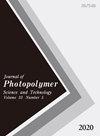在超高纯度化学品中获得低痕量金属的纯化方法
IF 0.7
4区 化学
Q4 POLYMER SCIENCE
Journal of Photopolymer Science and Technology
Pub Date : 2021-06-11
DOI:10.2494/photopolymer.34.205
引用次数: 1
摘要
和佐佐木。j . Photopolym。科学。抛光工艺。25岁。(2012) 389。7. 李先生,C-W。M. J.戈德堡J.阿普尔。理论物理。, 75(1994) 1410。随着对计算机处理器可靠性的要求不断提高,半导体制造中使用的材料的高纯度要求正被推向前所未有的水平。这些高纯度化学品的生产需要新的净化方法和技术,将低十亿分之一(ppb)的金属浓度有效地降低到低万亿分之一(ppt)。本文讨论的新方法将提出一种通过形成曲折路径的微通道划分流体的方法。这些微通道允许流体的进一步分离和收敛,从而将金属物质呈现到整个多孔基质的净化表面。离子交换能力是溶液中浓度和物质存在的函数。采用强酸和螯合两种离子交换化学方法制备了这些结构,并对它们的净化性能进行了评价和比较。此外,对这两种化学物质进行了系列评估,以证明其整体协同净化能力。本文章由计算机程序翻译,如有差异,请以英文原文为准。
Purification Method for Achieving Low Trace Metals in Ultra-High Purity Chemicals
and T. Sasaki. J. Photopolym. Sci. Technol., 25 . (2012) 389. 7. M. Ree, C-W. Chu, and M. J. Goldberg J. Appl. Phys., 75 (1994) 1410. The high purity requirements of materials used in semiconductor manufacturing are being pushed to unprecedented levels as demand for reliability in computer processors over increasingly longer lifetimes continues to rise. The production of these high purity chemicals requires new purification methods and technologies where the metal concentrations of low parts per billion (ppb) were effectively reduced to low parts per trillion (ppt). The new approach discussed in this paper would present a method for dividing the fluid through micro-channels that form tortuous pathways. These micro-channels allow for further dividing and converging of the fluid thereby presenting the metal species to the purifying surfaces throughout the porous matrix. The ion exchange capability was a function of the concentration and the presence of the species in the solution. Two ion exchange chemistries of strong acid and chelating were made into these structures and their purification performances were assessed and compared in terms of removal efficiencies. Furthermore, these two chemistries were evaluated in series to demonstrate the overall synergistic purification capabilities.
求助全文
通过发布文献求助,成功后即可免费获取论文全文。
去求助
来源期刊
CiteScore
1.50
自引率
25.00%
发文量
0
审稿时长
4-8 weeks
期刊介绍:
Journal of Photopolymer Science and Technology is devoted to the publication of articles on the scientific progress and the technical development of photopolymers.

 求助内容:
求助内容: 应助结果提醒方式:
应助结果提醒方式:


